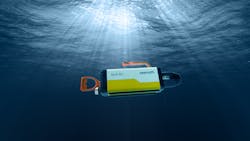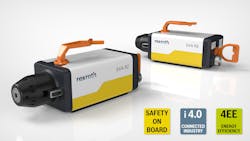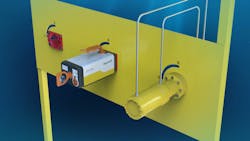Electric Valve Actuator Replaces Undersea Hydraulic Actuators
Content has been updated as of Oct. 13, 2021.
Engineers at Bosch Rexroth have developed an electric valve actuator (SVA R2) that can replace the hydraulic cylinders commonly used to open and close valves used in undersea oil drilling and recovery. The electric actuator is as compact and safe as hydraulic cylinders. It can operate for up to 25 years at locations 13,125 ft beneath the surface of the ocean without needing to change batteries or install ancillary hydraulics, pumps and hoses.
Until the new valve was developed, petroleum engineers relied on hydraulics to control oil flow in undersea applications. This required piping hydraulic fluid thousands of feet to the bottom of the ocean and back, which consumes a significant amount of power. But hydraulic cylinders were the only devices that could provide the necessary failsafe features in underwater applications. Providing the same level of safety with electric actuators (i.e., being able to quickly and securely close the valve in case of power outages and emergencies) was too complicated and expensive. Plus, batteries for electric valves could not be guaranteed for the valve’s 25-year operational life.
The new actuator includes an electric drive, motion-control hardware and a spring-based failsafe feature housed in a pressure-compensated container that lets it operate at depths of up to 13,125 ft (4,000 m). The actuator uses reliable, industrial and automotive components with proven track records of durability.
The field-proven safety feature lets the actuator meet Safety Integrity Level 3 (SIL 3) standards (IEC 61508 and IEC 61511). It was designed with oil and gas production in mind, but it will also work in systems that pump and transport CO2, H2 and water, and can be powered by the same power supply the actuator’s sensors rely on.
“The new SVA R2 actuator electrically opens and closes valves and adjusts the flow of valves that need accurate intermediate position control. This includes small-bore rotary valves such as 0.5-in. ball valves, 1-in. gate valves and 2-in. butterfly valves,” says Alexandre Orth, head of Subsea Automation Systems at Bosch Rexroth. “Though most valves only need 150 Nm to be opened or closed, the SVA actuator provides up to 225 Nm and can do so for 5,000 cycles. The actuator will also return the valve to its safe state, usually closed, even if power is lost, thanks to its spring-powered failsafe.”
Designing a failsafe subsystem that could close valves if power was lost was a significant engineering challenge. Including a typical electro-mechanical failsafe would make the hydraulic actuator twice as large as it is. That’s why the design team went with a simpler spring-powered failsafe. The team specified a helicoidal spring strong enough to handle the task and small enough so that the new actuator is roughly the same size as hydraulic actuators.
The SVA-R2 has built-in sensors that monitor the valve’s operational torque and absolute position. Companies can add more sensors for measuring ambient pressure, humidity, vibrations, or other parameters. This data gets sent topside to technicians for use in predicting failures. All this lets the SVA-R2 act not only as an actuator, but also as a multi-sensor platform for automating subsea processes. Power and data are sent over a single cable, which simplifies the overall system.
The actuator was designed to be operated and monitored remotely by technicians on the surface, but the designers had to ensure the SVA-R2 could be installed and removed by a remotely operated vehicle (ROV), which is basically a robotic submarine. Accordingly, they made sure the new actuator would weigh less than 220 lb so that the ROV would not need special tools or cranes to handle it. And all the interfaces comply with API 17H so ROV operators know exactly how to use them. The standards also ensure typical ROV can install or remove the actuator using typical ROV torque tools.
“Inside of the actuator, an embedded controller has a digital twin of itself and can compare real time sensor inputs with expected inputs,” says Orth. “This lets anomalies be discovered early and technicians can calculate when maintenance will be needed. The data can also be sent to a cloud server where artificial intelligence can analyze it.”
By automating valve monitoring and control, there is no need to send ROVs or divers, which can be dangerous and costly. And using standard interfaces and data-exchange protocols let oil/gas companies more easily expand or modernize current undersea networks and pipelines without having to lay more electrical or hydraulic lines.
Other benefits of the new actuator include:
- Reducing upfront cost by more than 20% compared to hydraulic actuators by eliminating the need for hydraulic power units, umbilicals, and power-distribution networks. Instead, it uses existing subsea electric-distribution networks.
- Lowering operating costs by using much less power. There’s also less need for maintenance, which lowers operating costs.
- Cleaner operation and fewer CO2 emissions, thanks to its lower power consumption. There’s also no risk of a hydraulic-fluid leak.
The actuator should work on any sized rotary actuators. The technology is currently limited to applications that need no more than 225 Nm of torque, but Bosch is working on developing versions of the SVA-R2 that can supply more torque.
Once the SVA-R2 valve is modified, it can be used for carbon capture and hydrogen production.
In some of the current schemes devised for carbon capture, CO2 from industrial onshore sources is sent through existing oil and gas pipelines to offshore sites where it gets stored in natural geological reservoirs beneath the ocean floor. The valves, which can be remotely controlled, lets designers automate some of the carbon transportation.
For offshore hydrogen production, the valves would control safe and efficient movement of hydrogen captured in onshore or underwater facilities to underwater reservoirs or waiting transport ships.
About the Author
Stephen Mraz
Steve serves as Senior Editor of Machine Design. He has 23 years of service and has a B.S. Biomedical Engineering from Steve was a Flight officer in the U.S. Navy. He is currently responsible for areas such as aerospace and medical.

Leaders relevant to this article:


